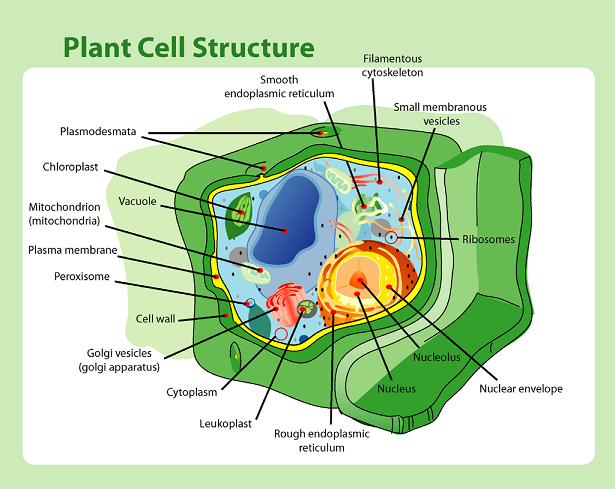Plant structure and development is a topic which considers plant synthesis at both the cellular and organismal levels and how this influences plant growth. Plant structure focuses more intimately with concepts related to plant anatomy. Whereas, plant development highlights how the organelles and parts of a plant influence the process of growth and the final morphology achieved.
Figure 1 below presents a simple, schematic diagram of a plant cell and the organelles which are contained in the cell.

Figure 1. This image of a plant cell has been taken from http://en.wikipedia.org/wiki/File:Plant_cell_structure.png. Plant cells contain chloroplasts and a cell wall, organelles which are not present in animal cells.
The organelles present in the plant cell in Figure 1 are evident in all somatic cells of a plant. This machinery works together to transport nutrients, waste and proteins in and out of the cell. Furthermore, the chloroplasts represent the photosynthetic machinery which allows a plant to produce glucose and the mitochondrion is the organelle where cellular respiration occurs.
At the organism level, a plant has two main organs. One of these organs is the shoot system, which is comprised of all parts of the plant which are above the ground, such as the leaves and stem. The other main organ is the root system, which is composed of all parts of the plant which are below the ground such as rhizomes.
Plants develop from the meristems and as they develop their cells get grouped into different tissues. These tissues are the dermal tissue, vascular tissue and ground tissue. Figure 2 below shows the components of the vascular tissue found in plants. The transportation of molecules such as food and water, are transported by the vascular tissue.
Figure 2 below presents an image of a plant at the organismal level.

Figure 2. This labelled image is a depiction of a single plant organism and has been taken from http://commons.wikimedia.org/wiki/File:Stem-cross-section2.jpg.
This discussion on the topic of plant structure and development is in no way a comprehensive summary. Rather, this description simply introduces some of the basic concepts related to this topic.
© BrainMass Inc. brainmass.com April 19, 2024, 5:43 pm ad1c9bdddf